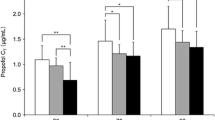Abstract
Objective: The assessment of propofol to produce diurnal sedation in critically ill patients Design: Prospective clinical study Setting: Intensive Care Unit, University Hospital Patients and participants: Thirty consecutive patients admitted to the Intensive Care Unit older than 18 years who were expected to be sedated for more than 50 h Interventions: The patients were randomised into two groups. All received sedation with a constant background infusion of morphine and a variable infusion rate of propofol, which was altered hourly to maintain the intended sedation score. The first group received constant light sedation (CLS) over 50 h aiming for a Ramsay score of 2–3. The second group received CLS between 0600 h and 2200 h and additional night sedation (ANS) with propofol between 2200 h and 0600 h, aiming for a sedation score of 4–5. Measurements and results: Patients were studied for 50 h from 1800 h on the first day of admission. Recordings of heart rate, blood pressure, sedation scores and propofol and morphine infusion rates were made hourly. An APACHE II score was recorded for each patient. Sedation scores were analysed by blind visual assessment and cosinor analysis, which is used in chronobiology to examine the correlation of data with a cosine curve. Patients in the ANS group had significantly better rhythmicity of sedation levels using cosinor analysis (r = 26 % v 8 %) p < 0.01. There was no difference between the CLS and ANS groups with respect to age, sex or APACHE II scores. Nine out of 15 patients in the ANS group achieved diurnal sedation. Three patients in the CLS group showed diurnal rhythmicity of sedation, which can be attributed to natural sleep, and had a median APACHE II score of 12. Five patients in the CLS group and three in the ANS group showed a deep constant sedation pattern. They had high APACHE II scores (median 21.5) and an obtunded conscious level on admission due to severe sepsis. Conclusion: Propofol can safely provide diurnal sedation in the critically ill when titrated against the Ramsay score. Sedation levels cannot be manipulated in some severely ill patients.
Similar content being viewed by others
Author information
Authors and Affiliations
Additional information
Received: 7 August 1996 Accepted: 16 January 1997
Rights and permissions
About this article
Cite this article
McLeod, G., Wallis, C., Dick, J. et al. Use of 2 % propofol to produce diurnal sedation in critically ill patients. Intensive Care Med 23, 428–434 (1997). https://doi.org/10.1007/s001340050352
Issue Date:
DOI: https://doi.org/10.1007/s001340050352




